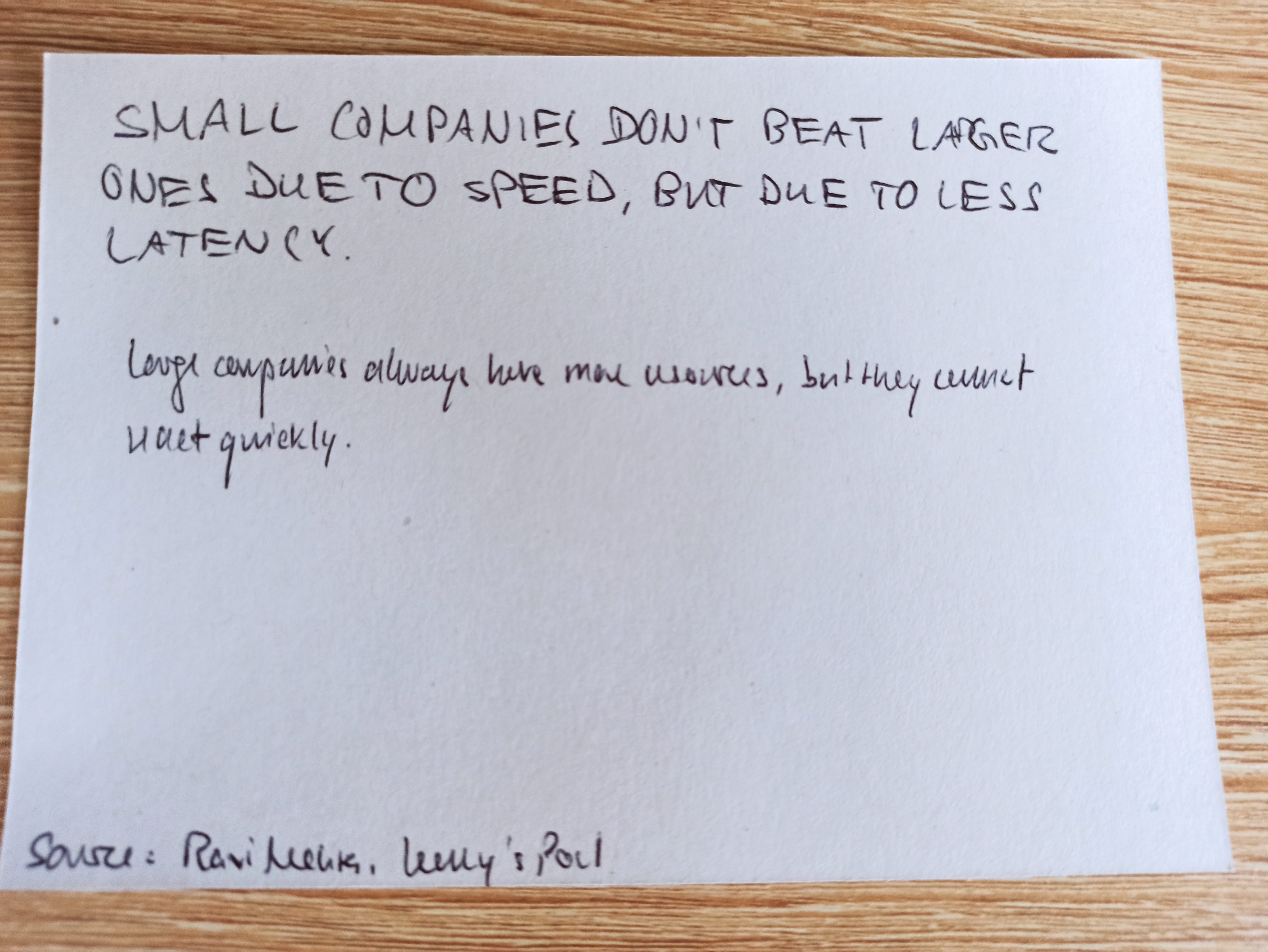International Generalist #9: index cards, value creation, and wild animals.
Remember what you read by writing index cards daily, using the Index Card Method. Value creation vs value capture. How wild animals impact climate change.
Welcome to the 9th edition of International Generalist. Today, we’ll look at a system to build an external brain, the distinction between value creation and value capture, and how wild animals impact climate change.
If you don’t find this valuable, you can always unsubscribe at the bottom of this email. If you like it, tell your friends to subscribe here. It’s the best way to support this newsletter. :)
Let’s dive in.
[1] Using index cards as your second brain
I find it very difficult to retain things I’ve read in books or learned in podcasts. I tried different things:
- taking notes while reading (which made reading so effortful that I simply stopped doing it)
- writing book takeaway blog posts after reading (which I did three times, and then quit, because the effort was too high)
- bookmarking interesting spots in Audible (only to never go back to them as I have way too many)
None of these worked. Too effortful, too complex.
I needed something easier and simpler.
So I went back to my middle school days, and bought a pack of 500 A6 white, blank index cards.
Now, whenever I read or learn something interesting, I write it down in an A6 index card.
This is my format:
Headline that explains the main concept
More text that explains the concept further
Source description
Let’s take a look at a real example:

Headline: small companies don’t beat larger ones due to speed, but due to less latency.
Body: large companies have more resources, but they cannot move quickly.
Source: Lenny’s Podcast w/ Ravi Mehta
The information on this card isn’t conclusive, but it’s enough to help me remember the concept - and that’s what matters.
(I have quoted this several times actually and adjusted some of my work approach thanks to this insight.)
There are two triggers on which I write an index card:
- I have one on hand and write something down directly when I read it (fairly obvious)
- I sit down in the evening and reflect on what I learned during the day (not so obvious)
In the evening, I try to make it part of my evening routine to spend 5-10 minutes writing down the things I learned today. This helps getting away from screens, putting thoughts on paper, re-engaging the brain to remember important concepts during sleep, and usually yields 3-5 new index cards.
Every now and then, I go through the stack and review the concepts (irregular spaced repetition, if you will).
Every now and then usually means when I’m running out of stuff to write. 😄
And that’s exactly what it’s for:
- Remembering newly learned concepts better
- Having a never-ending stream of interesting content (+ potentially the base layer for a long-form post or a book)
- Dumping thoughts from my brain on paper
Get some index cards and give it a try. I absolutely adore them.
[2] Value creation vs value capture, and how it applies to startups
Ben and David at the Acquired Podcast always talk about the concept of “value creation” vs “value capture”.
Let’s illustrate these two concepts using Google AdWords as example, and assume a customer is worth 5.000 € to you (its customer lifetime value).
Thanks to Google AdWords, you acquire 5 new customers in a given month. Hence, Google AdWords created 25.000 € in value for you.
You paid 1.000 € for each new client, so 5.000 € in total. That’s the value that Google captured.
A good business is one that creates more value than it captures.
A great business is one that understands how it can capture more of the value it creates.
Once you understand this concept, you understand why B2B businesses are more highly regarded than B2C/B2G businesses.
In B2B, you can quantify the value you create either in terms of cost savings or revenue increases. That makes it easy to capture more of it.
In B2C/B2G, value provided isn’t just monetary and thus harder to quantify (something I struggle with on a daily basis, selling software to schools who don’t care about costs or revenues).
Create value. Capture some of it. Then, figure out how to increase the % of value captured while increasing the overall value created.
[3] The impact of wild animals on climate change

Wild animals could be the key to fighting climate change, a paper recently published in Nature (and explained in this Bloomberg article). Here are a few of my takeaways:
Tree planting has been all the rage, but we’ve forgotten that grasslands, tundras, and oceans also contribute to negative carbon emissions.
Trees alone might not be enough. The more animals are present, the better forests are faring, as animals “animate the carbon cycle”.
Wildebeests graze the Serengeti. This leads to less grass available, and hence less wildfires - that emit a ton of Carbon.
Same goes for the arctic tundra. Musk oxen compact the snow, which keeps the ground frozen, keeping the stored Methane where it should be.
Whales take a ton of carbon to the ocean floor when they die.
Other animals eat fruit, distribute seeds, and cause more plants to grow, which captures carbon.
Re-wilding in itself isn’t the answer either, but it’s part of the puzzle.
Zooming out and treating the problem holistically shows interactions (and solutions!) that previously weren’t visible.
You can observe this pattern everywhere: in the human body, in business, in social interactions.
Zoom out to zoom in.
—
Action item recap:
- Get some index cards. Take notes on your learnings.
- Spend a few minutes every evening writing down what you learned.
- Understand how much value you create, and how you can capture (more of) it.
- Consider doing something for animal diversity, as it might be a key to tackling climate change.
- Zoom out to zoom in.
—
That’s it for this edition of International Generalist. Thanks for tuning in and reading!
If you enjoyed this, please ask yourself: which one person that you know would most benefit from reading this newsletter? The number one way to support me is to share this with others aspiring to become more effective in their personal and professional lives.
Who’s behind International Generalist?
I’m Dominik, and every day, I try to figure out how to become a tiny bit more effective. Then, I share some of the lessons learned here.
When I’m not writing, I build the international business for Sdui - the Leading European SchoolOS -, play Lacrosse, lift weights and enjoy draft beers.
Here’s how else I can help you:
- Book a 1:1 meeting to discuss the international expansion strategy of your startup
- Read the newsletter archive for more actionable nuggets
- Connect on LinkedIn or Twitter for daily doses of insights
- Send me a question, so I can answer it in the newsletter or in a long-form blog post
See you in two weeks!
Much love
Dominik
PS - my wonderful colleague Hakim shared this French quote with me:
“Everybody wants to go to heaven, but no one wants to die.”
Go put in the work towards your goals.
Dominik Nitsch Newsletter
Join the newsletter to receive the latest updates in your inbox.


